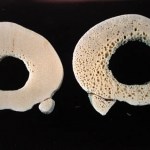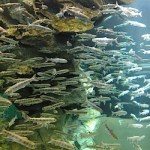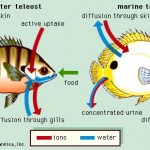water
Research published July 3 in the journal BMC Evolutionary Biology supports the idea that some species of spiders can catch the wind to "sail" across bodies of water, which they suggest might be why certain spiders seem to be all over the world. While some spiders were already know to catch the breeze to travel by air relatively short distances, and some are known to be aquatic, the researchers in this study were interested in examining just how well spiders could actually walk on water. So, they collected 325 wild spiders and dropped them on water to see what…
by Peter Gleick and Heather Cooley
Debates about water in California, the western U.S., and indeed, worldwide, have traditionally focused on the question of how best to further expand water supply to meet some hypothetical future increase in water demand. And the solution frequently offered is to build massive new infrastructure in the form of dams and reservoirs, drill more groundwater wells, or expand water diversions from ever-more-distant rivers, in order to “grow” the supply available for human use.
“Build more traditional water infrastructure” is increasingly the wrong answer to the…
It’s only natural that during a crisis we look to single, “silver bullet” technical solutions, after all, they are supposed to be effective against werewolves, witches, and other monsters. For monsters like the ongoing severe California drought, the current favorite silver bullet is seawater desalination. And why not? California sits at the edge of the largest body of salt water in the world – the Pacific Ocean – and taking salt out of water is a successful, commercial, well-understood technology.
Look at how Israel has solved their water problems by building desalination plants, we’re…
Factory farms in the US---the confinements that house millions of beef cattle, dairy cows, hogs and poultry--- generate enough manure to fill the 102-story Empire State Building each and every day. That's more than 13 times the sewage produced by the US population.
This factoid and many others are presented in Factory Farm Nation 2015, a report released this week by Food & Water Watch (FWW). The report describes the dominance of factory farms in US agriculture and its affect on the physical, economic, and social environment. It provides examples of consolidation within…
[As part of the Pacific Institute’s ongoing efforts to evaluate the impacts of the California drought and offer strategies, technologies, and policies to reduce those impacts, we are presenting a series of short assessments on “Understanding the Numbers.” This piece is the part of that series.]
California is a wonderful place to grow food. The climate is highly favorable; soils are some of the best in the world, it is located well to serve global distribution markets with major ports and other transportation infrastructure; and normally, some regions are relatively well-watered.
Normally.
In…
California’s hottest and driest drought in recorded history has shifted the sources of electricity with adverse economic and environmental consequences. The Pacific Institute has just completed and released a report that evaluates how diminished river flows have resulted in less hydroelectricity, more expensive electricity from the combustion of natural gas, and increased production of greenhouse gas emissions.
The current severe drought has many negative consequences. One of them that receives little attention is how the drought has fundamentally changed the way our electricity is produced.…
A new study published in the Journal of the Royal Society Interface from a team of researchers (University of the Sunshine Coast, James Cook University, University of Queensland, Australia, and the University of Oxford) described how geckos living in humid areas manage to stay dry.
The researchers used a scanning electron microscope to take a closer look at the skin of box-patterned geckos (Lucasium steindachneri), which is how they discovered the dense microscopic spiny hairs that are also found in other species of geckos. The hairs trap air and the tips of the hair help gather water into…
If there is anything that the past few decades of research and study of major global challenges tells us, it is that truly effective solutions to sustainability challenges require truly integrated approaches across disciplines, fields of study, data sets, and institutions. We are not going to solve 21st century global problems with 20th century tools.
The planet is faced with a wide range of regional and global threats: air and water pollution, loss of biodiversity, a rapidly changing climate and new risks from extreme weather events, energy and food security, conflicts over resources…
By Peter Gleick (Pacific Institute) and Carl Ganter (Circle of Blue)
1. The California Drought Becomes an Emergency
California’s multi-year drought grew dire enough in 2014 to prompt Governor Jerry Brown to declare a drought emergency in January. By the end of the year, California had experienced the driest and hottest 36 months in its 119-year instrumental record. Some researchers described the drought as 1) the worst in over 1200 years and 2) evidence of rising temperatures globally as climate changes accelerate. As of mid-January, the drought is continuing.
As the California and…
The California drought continues.
While we do not know yet what the rest of the wet season will bring – and while we hope for the major storms needed to recharge our rivers, groundwater and reservoirs – it seems increasingly likely that California will not see enough precipitation to get out of the very deep deficit that three years of drought (so far) have produced.
There is, however, some misleading and confusing information out there. Some are already arguing that California’s rainfall is nearly back to normal or that because there may have been more serious droughts in the past we needn’t…
Guest Post: Matthew Heberger Pacific Institute, Oakland, California
New monthly water use data for California water utilities shows that residential water use varies widely around the state, and that the response to the drought has been uneven. Moreover, in some areas, residential use averages more than 500 gallons per person per day, indicating that we could be doing much more to save water.
In July, the State Water Resources Control Board, or the Water Board, issued an emergency regulation to increase water conservation in urban areas. The new regulations prohibit certain water uses, like…
The most important trend in the use of water is the slowly unfolding story of peak water in the United States and elsewhere. Data on US water use are compiled every five years by the US Geological Survey, covering every state and every sector of the economy. The latest data – for 2010 – have just been released, and they show the continuation and acceleration of a stunning trend: US water withdrawals, for all purposes, are declining, not growing.
Traditional water planning and management assume inevitable, continuing, lockstep growth in demand for water as populations and economies expand.…
As input to the ongoing discussions about how to meet and overcome the spreading risks of Ebola, here are some summary thoughts about the water-related components of U.S. efforts. Specifics about the operations and effectiveness of water treatment or supply technologies, or the medical and health implications of their use must be verified by the designers/makers of the technology along with medical experts from the US Centers for Disease Control (CDC), World Health Organization (WHO), West African health and water officials, and related institutions.
1. Water Supply…
Image from the American Physiological Society's website.http://www.the-aps.org/mm/Conferences/APS-Conferences/2014-Conferences/…
As anticipated, the meeting today was excellent! Here are some highlights from today:
Dr. Michael Joyner (Mayo Clinic) spoke about how we should reconsider animal models that are used in research as laboratory rodents can be manipulated to match their genotype to their phenotype. In other words, researchers modify the animal's genome to produce a specific disease or attribute they are interested in studying. The problem with this approach is that genes can be…
In the 20th century, society was either ignorant of, or ignored, the consequences of bad water management. The goal was economic development at all costs. Over the past few decades, we've learned about the ecological and social implications of the misuse of water, and some efforts have been made to protect natural ecosystems, restore a modicum of flows, bring local communities into the discussion about water policy and infrastructure. These are steps in the right direction.
But sometimes our failures have been monumental -- and uncorrected.
Perhaps the best, or worst, example, is the…
In the past few weeks, I have had been asked the same question by reporters, friends, strangers, and even a colleague who posts regularly on this very ScienceBlogs site (the prolific and thoughtful Greg Laden): why, if the California drought is so bad, has the response been so tepid?
There is no single answer to this question (and of course, it presumes (1) that the drought is bad; and (2) the response has been tepid). In many ways, the response is as complicated as California’s water system itself, with widely and wildly diverse sources of water, uses of water, prices and water rights,…
Image of Biwa salmon from the Lake Biwa Museum (http://www.lbm.go.jp/english/exhibits/aquarium.html)
It is not surprising that Biwa salmon (image above), a subspecies of Oncorhyncus masou, do not adapt to seawater very well after having been landlocked in Lake Biwa, Japan for the last 500,000 years or so. Researchers from Hokkaido University and Shiga Prefecture Fishery Experiment Station in Japan wanted to know what caused the salmon to lose their ability to thrive in salt water. In a new paper published in the American Journal of Physiology they compared the…
Freshwater fish are in a constant battle with their environment when it comes to maintaining their electrolyte balance as they are continuously losing ions to the surrounding water. Therefore, they have to actively absorb ions such as sodium, calcium and chloride from the water (see figure below). Prior research has shown that acidic environments cause adult and larva zebrafish to increase sodium uptake from their environment.
Depiction of water and salt homeostasis in freshwater and marine fish.
Researchers Kumai et al (University of Ottowa, Ontario, Canada) have provided evidence to…
Snapshots from the New National Climate Assessment
After three years of intensive effort, research, writing, and review by hundreds of climate scientists, the latest update of the U.S. National Climate Assessment was released today. It includes many long, carefully prepared sectoral and regional studies, and covers the massive range of effects of climate change on the nation, including both changes already observed and expected in the future.
There are hundreds of pages of information, observations, projections, and conclusions to absorb – almost all of it bad news. Here, in short form and in…
Getting down and dirty with boots on the ground is one trait of a successful community organizer. It could also describe the work of the most-skilled epidemiologists. ATSDR scientist Frank Bove, ScD’s past experience with the first—an organizer from 1975 to 1982--makes him especially effective at the second.
Last month, Bove was recognized by the Boston University School of Public Health with the 2014 David Ozonoff Unsung Hero Award for his work. Bove has been the lead researcher in the Agency for Toxic Studies and Disease Registry’s (ATSDR) investigation of U.S. Marine Corps base Camp…



